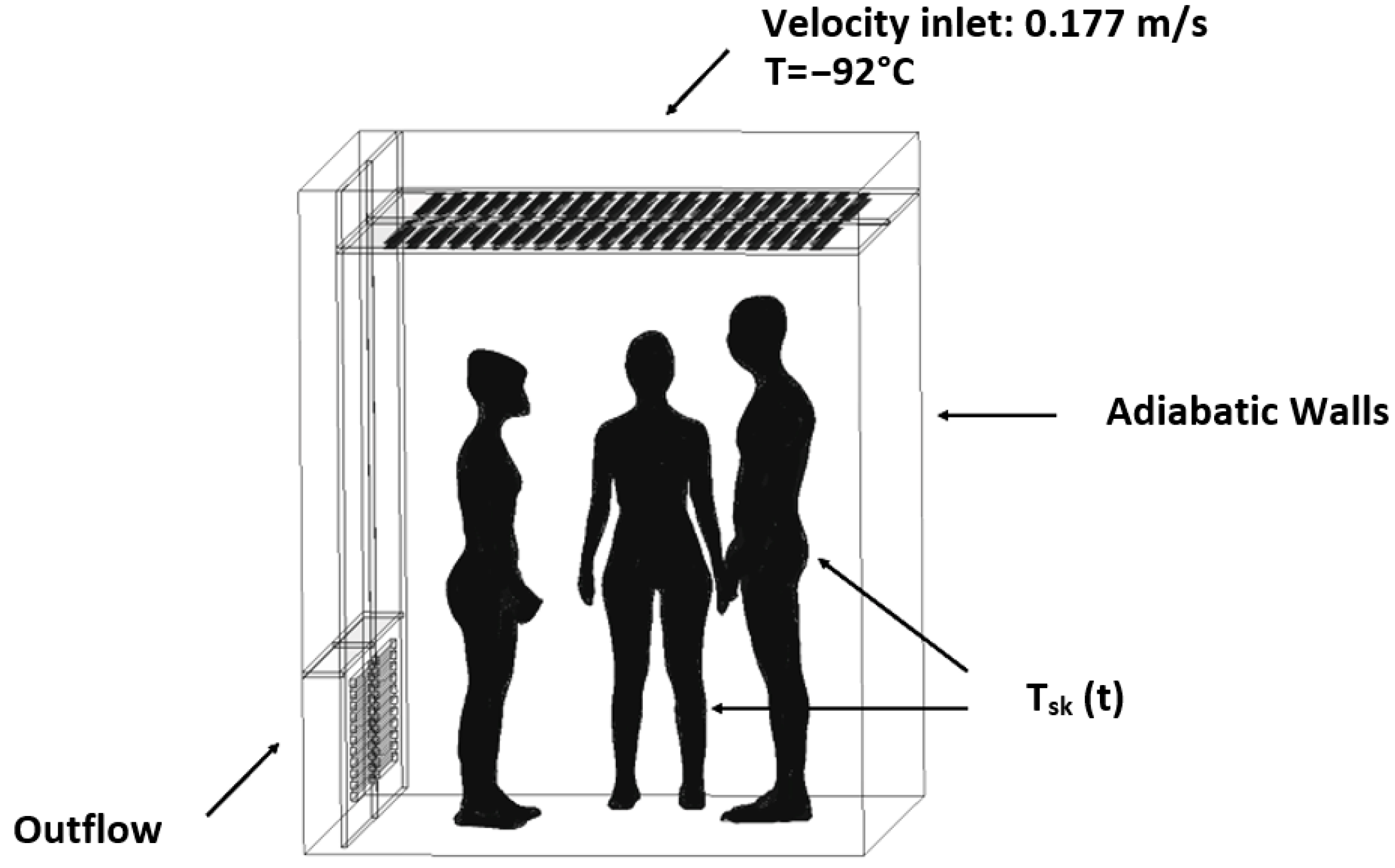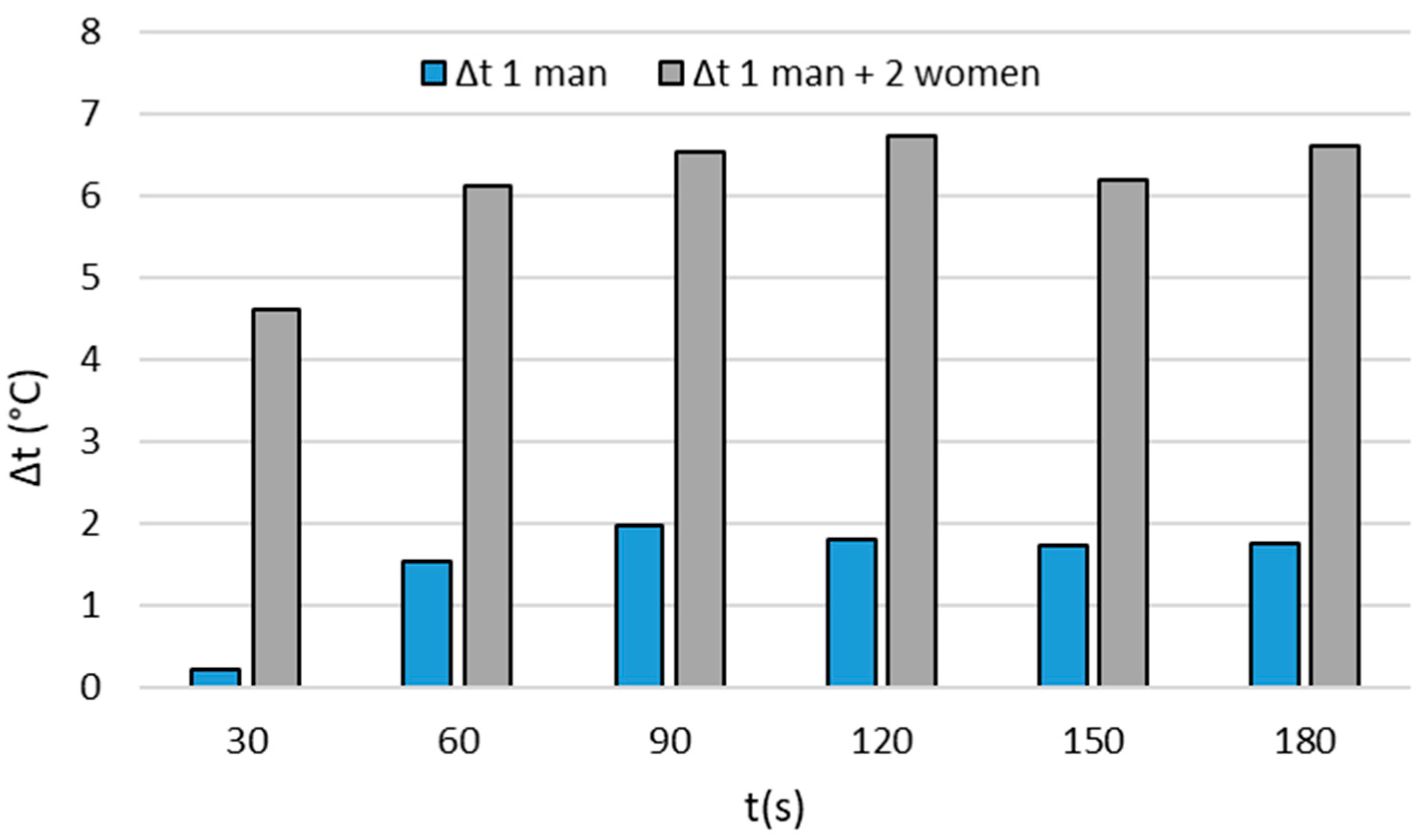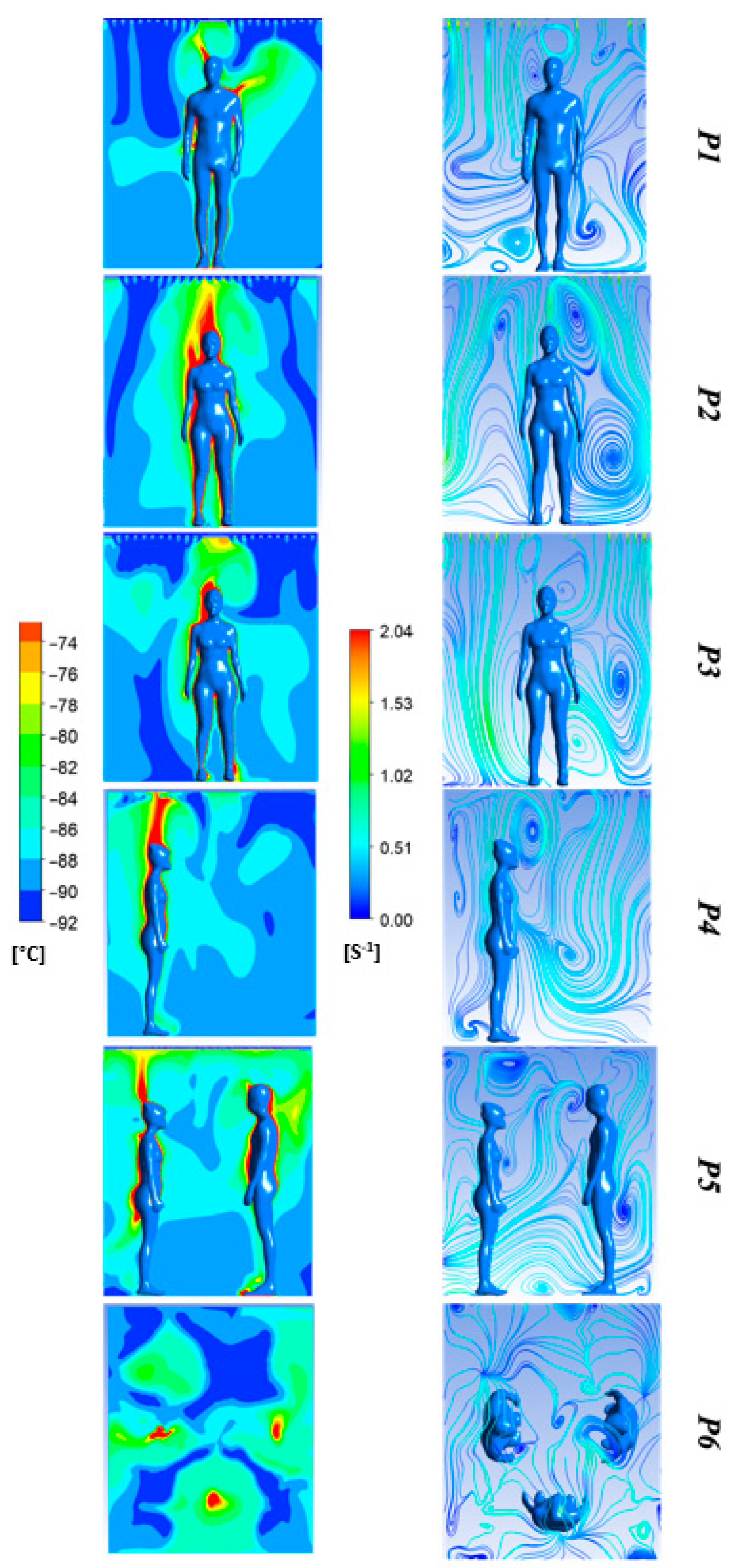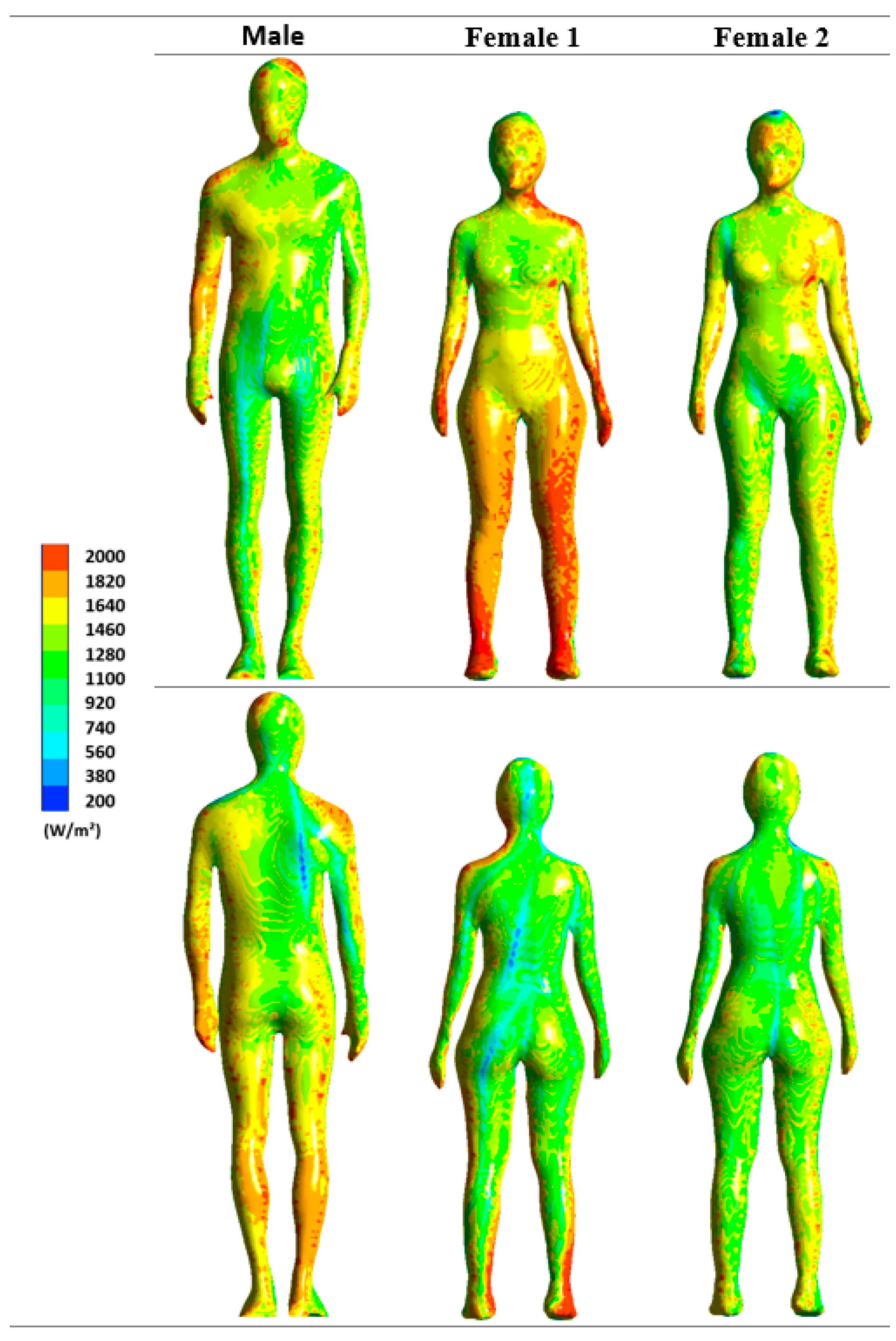Investigating Heat Transfer in Whole-Body Cryotherapy: A 3D Thermodynamic Modeling Approach with Participant Variability
Abstract
:1. Introduction
2. Materials and Methods
2.1. Geometry and Computational Domain
2.2. Boundary Conditions
2.3. Computational Grid
2.4. Numerical Methods
3. Results
4. Discussion
5. Conclusions
- The simultaneous presence of multiple patients disrupts thermal homogeneity, resulting in an overall rise in temperature within the enclosure;
- This disruption is associated with the thermal stratification induced by the density disparity between cold and warm air, leading to a convection phenomenon and the formation of a convective thermal boundary layer enveloping the human body;
- The results suggest a temperature difference of approximately 6.7 °C between an empty cryotherapy chamber and one with three patients;
- Based on a mathematical model derived from experimental data, it is estimated that, compared to the reference case, the average skin temperature would be higher by approximately 0.4 °C with three patients;
- This study highlights the importance of patients’ positions in the chamber, influencing the non-uniform distribution of surface thermal flux;
- This variability can lead to noteworthy differences in skin cooling, a critical aspect for achieving recommended analgesic thresholds.
Limitations
Author Contributions
Funding
Institutional Review Board Statement
Informed Consent Statement
Data Availability Statement
Conflicts of Interest
References
- Bouzigon, R.; Grappe, F.; Ravier, G.; Dugue, B. Whole- and Partial-Body Cryostimulation/Cryotherapy: Current Technologies and Practical Applications. J. Therm. Biol. 2016, 61, 67–81. [Google Scholar] [CrossRef]
- Westerlund, T.; Oksa, J.; Smolander, J.; Mikkelsson, M. Thermal Responses During and After Whole-Body Cryotherapy (−110 °C). J. Therm. Biol. 2003, 28, 601–608. [Google Scholar] [CrossRef]
- Legrand, F.D.; Dugué, B.; Costello, J.; Bleakley, C.; Miller, E.; Broatch, J.R.; Polidori, G.; Lubkowska, A.; Louis, J.; Lombardi, G.; et al. Evaluating Safety Risks of Whole-Body Cryotherapy/Cryostimulation (WBC): A Scoping Review from an International Consortium. Eur. J. Med. Res. 2023, 28, 387. [Google Scholar] [CrossRef]
- Sadura-Sieklucka, T.; Sołtysiuk, B.; Karlicka, A.; Sokołowska, B.; Kontny, E.; Księżopolska-Orłowska, K. Effects of Whole-Body Cryotherapy in Patients with Rheumatoid Arthritis Considering Immune Parameters. Rheumatology 2019, 57, 320–325. [Google Scholar] [CrossRef]
- Księżopolska-Orłowska, K.; Pacholec, A.; Jędryka-Góral, A.; Bugajska, J.; Sadura-Sieklucka, T.; Kowalik, K.; Pawłowska-Cyprysiak, K.; Łastowiecka-Moras, E. Complex Rehabilitation and the Clinical Condition of Working Rheumatoid Arthritis Patients: Does Cryotherapy Always Overtop Traditional Rehabilitation? Disabil. Rehabil. 2016, 38, 1034–1040. [Google Scholar] [CrossRef]
- Gizińska, M.; Rutkowski, R.; Romanowski, W.; Lewandowski, J.; Straburzyńska-Lupa, A. Effects of Whole-Body Cryotherapy in Comparison with Other Physical Modalities Used with Kinesitherapy in Rheumatoid Arthritis. BioMed. Res. Int. 2015, 2015, e409174. [Google Scholar] [CrossRef]
- Stanek, A.; Cholewka, J.; Gadula, J.; Drzazga, Z.; Sieron, A.; Sieron-Stoltny, K. Can Whole-Body Cryotherapy with Subsequent Kinesiotherapy Procedures in Closed Type Cryogenic Chamber Improve BASDAI, BASFI, and Some Spine Mobility Parameters and Decrease Pain Intensity in Patients with Ankylosing Spondylitis? BioMed. Res. Int. 2015, 2015, e404259. [Google Scholar] [CrossRef] [PubMed]
- Stanek, A.; Cholewka, A.; Wielkoszyński, T.; Romuk, E.; Sieroń, A. Decreased Oxidative Stress in Male Patients with Active Phase Ankylosing Spondylitis Who Underwent Whole-Body Cryotherapy in Closed Cryochamber. Oxid. Med. Cell. Longev. 2018, 2018, e7365490. [Google Scholar] [CrossRef] [PubMed]
- Straburzyńska-Lupa, A.; Kasprzak, M.P.; Romanowski, M.W.; Kwaśniewska, A.; Romanowski, W.; Iskra, M.; Rutkowski, R. The Effect of Whole-Body Cryotherapy at Different Temperatures on Proinflammatory Cytokines, Oxidative Stress Parameters, and Disease Activity in Patients with Ankylosing Spondylitis. Oxid. Med. Cell. Longev. 2018, 2018, e2157496. [Google Scholar] [CrossRef] [PubMed]
- Vitenet, M.; Tubez, F.; Marreiro, A.; Polidori, G.; Taiar, R.; Legrand, F.; Boyer, F. Effect of Whole Body Cryotherapy Interventions on Health-Related Quality of Life in Fibromyalgia Patients: A Randomized Controlled Trial. Complement. Ther. Med. 2018, 36, 6–8. [Google Scholar] [CrossRef] [PubMed]
- Miller, E.; Kostka, J.; Włodarczyk, T.; Dugué, B. Whole-Body Cryostimulation (Cryotherapy) Provides Benefits for Fatigue and Functional Status in Multiple Sclerosis Patients. A Case–Control Study. Acta Neurol. Scand. 2016, 134, 420–426. [Google Scholar] [CrossRef]
- Pournot, H.; Bieuzen, F.; Louis, J.; Fillard, J.-R.; Barbiche, E.; Hausswirth, C. Time-Course of Changes in Inflammatory Response after Whole-Body Cryotherapy Multi Exposures following Severe Exercise. PLoS ONE 2011, 6, e22748. [Google Scholar] [CrossRef]
- Ziemann, E.; Olek, R.A.; Grzywacz, T.; Kaczor, J.J.; Antosiewicz, J.; Skrobot, W.; Kujach, S.; Laskowski, R. Whole-Body Cryostimulation as an Effective Way of Reducing Exercise-Induced Inflammation and Blood Cholesterol in Young Men. Eur. Cytokine Netw. 2014, 25, 14–23. [Google Scholar] [CrossRef]
- Ferreira-Junior, J.B.; Bottaro, M.; Vieira, A.; Siqueira, A.F.; Vieira, C.A.; Durigan, J.L.Q.; Cadore, E.L.; Coelho, L.G.M.; Simões, H.G.; Bemben, M.G. One Session of Partial-Body Cryotherapy (−110 °C) Improves Muscle Damage Recovery. Scand. J. Med. Sci. Sports 2015, 25, e524–e530. [Google Scholar] [CrossRef]
- Rymaszewska, J.; Tulczynski, A.; Zagrobelny, Z.; Kiejna, A.; Hadrys, T. Influence of Whole Body Cryotherapy on Depressive Symptoms—Preliminary Report. Acta Neuropsychiatr. 2003, 15, 122–128. [Google Scholar] [CrossRef]
- Rymaszewska, J.; Ramsey, D.; Chładzińska-Kiejna, S. Whole-Body Cryotherapy as Adjunct Treatment of Depressive and Anxiety Disorders. Arch. Immunol. Ther. Exp. 2008, 56, 63–68. [Google Scholar] [CrossRef] [PubMed]
- Douzi, W.; Dupuy, O.; Tanneau, M.; Boucard, G.; Bouzigon, R.; Dugué, B. 3-Min Whole Body Cryotherapy/Cryostimulation after Training in the Evening Improves Sleep Quality in Physically Active Men. Eur. J. Sport Sci. 2019, 19, 860–867. [Google Scholar] [CrossRef] [PubMed]
- Polidori, G.; Elfahem, R.; Abbes, B.; Bogard, F.; Legrand, F.; Bouchet, B.; Beaumont, F. Preliminary Study on the Effect of Sex on Skin Cooling Response During Whole Body Cryostimulation (−110 °C): Modeling and Prediction of Exposure Durations. Cryobiology 2020, 97, 12–19. [Google Scholar] [CrossRef] [PubMed]
- Elfahem, R.; Bouchet, B.; Abbes, B.; Polidori, G.; Beaumont, F. Influence of Body Heat Loss on Temperature and Velocity Fields in a Whole-Body Cryotherapy Chamber. Fluids 2023, 8, 9. [Google Scholar] [CrossRef]
- Elfahem, R.; Abbes, B.; Bouchet, B.; Murer, S.; Bogard, F.; Moussa, T.; Beaumont, F.; Polidori, G. Whole-Body Cryostimulation: New Insights in Thermo-Aeraulic Fields Inside Chambers. Inventions 2023, 8, 4. [Google Scholar] [CrossRef]
- Marreiro, F.; Beaumont, F.; Taïar, R.; Polidori, G. Application des Techniques d’Imagerie Thermique Infrarouge et de Mécanique des Fluides Numérique à la Cryothérapie Corps Entier (CCE). Instrum. Mes. Métrologie 2017, 6, 11–32. [Google Scholar]
- Gagge, A.P.; Gonzalez, R.R. Mechanisms of heat exchange: Biophysics and physiology. In Handbook of Physiology. Section 4: Environmental Physiology; Fregley, M.J., Blatteis, C.M., Eds.; Oxford University Press: New York, NY, USA, 1996; pp. 45–84. [Google Scholar]
- Parsons, K.C. Human Thermal Environments, 2nd ed.; Taylor & Francis: London, UK, 2003. [Google Scholar]
- Craven, B.A.; Settles, G.S. A Computational and Experimental Investigation of the Human Thermal Plume. J. Fluids Eng. 2006, 128, 1251–1258. [Google Scholar] [CrossRef]
- Liu, Y.; Liu, Z.; Luo, J. Numerical Investigation of the Unsteady Thermal Plume Around Human Body in Closed Space. Procedia Eng. 2015, 121, 1919–1926. [Google Scholar] [CrossRef]
- Blokker, T.; Bucher, E.; Steiner, T.; Wehrlin, J.P. Effect of cold ambient temperature on heat flux, skin temperature, and thermal sensation at different body parts in elite biathletes. Front. Sports Act. Living 2022, 4, 966203. [Google Scholar] [CrossRef] [PubMed]
- Kenny, G.P.; Flouris, A.D. The human thermoregulatory system and its response to thermal stress. In Protective Clothing; Wang, F., Gao, C., Eds.; Woodhead Publishing Series in Textiles; Woodhead Publishing: Sawston, UK, 2014; pp. 319–365. [Google Scholar]
- Burkov, I.A.; Kolishkin, L.M.; Pushkarev, A.V.; Shakurov, A.V.; Tsiganov, D.I.; Zherdev, A.A. Experimental and computational thermal analysis of partial-body cryotherapy. Int. J. Heat Mass Transf. Part C 2022, 183, 122194. [Google Scholar] [CrossRef]
- Costello, J.T.; McInerney, C.D.; Bleakley, C.M.; Selfe, J.; Donnelly, A.E. The Use of Thermal Imaging in Assessing Skin Temperature Following Cryotherapy: A Review. J. Therm. Biol. 2012, 37, 103–110. [Google Scholar] [CrossRef]
- Mourot, L.; Cluzeau, C.; Regnard, J. Hyperbaric gaseous cryotherapy: Effects on skin temperature and systemic vasoconstriction. Arch. Phys. Med. Rehabil. 2007, 88, 1339–1343. [Google Scholar] [CrossRef]
- Cholewka, A.; Stanek, A.; Sieroń; A; Drzazga, Z. Thermography study of skin response due to whole-body cryotherapy. Skin Res. Technol. 2012, 18, 180–187. [Google Scholar] [CrossRef]
- Bleakley, C.M.; Hopkins, J.T. Is it possible to achieve optimal levels of tissue cooling in cryotherapy? Phys. Ther. Rev. 2010, 15, 344–350. [Google Scholar] [CrossRef]







Disclaimer/Publisher’s Note: The statements, opinions and data contained in all publications are solely those of the individual author(s) and contributor(s) and not of MDPI and/or the editor(s). MDPI and/or the editor(s) disclaim responsibility for any injury to people or property resulting from any ideas, methods, instructions or products referred to in the content. |
© 2024 by the authors. Licensee MDPI, Basel, Switzerland. This article is an open access article distributed under the terms and conditions of the Creative Commons Attribution (CC BY) license (https://creativecommons.org/licenses/by/4.0/).
Share and Cite
Elfahem, R.; Bouchet, B.; Abbes, B.; Legrand, F.; Polidori, G.; Beaumont, F. Investigating Heat Transfer in Whole-Body Cryotherapy: A 3D Thermodynamic Modeling Approach with Participant Variability. Fluids 2024, 9, 61. https://doi.org/10.3390/fluids9030061
Elfahem R, Bouchet B, Abbes B, Legrand F, Polidori G, Beaumont F. Investigating Heat Transfer in Whole-Body Cryotherapy: A 3D Thermodynamic Modeling Approach with Participant Variability. Fluids. 2024; 9(3):61. https://doi.org/10.3390/fluids9030061
Chicago/Turabian StyleElfahem, Rim, Bastien Bouchet, Boussad Abbes, Fabien Legrand, Guillaume Polidori, and Fabien Beaumont. 2024. "Investigating Heat Transfer in Whole-Body Cryotherapy: A 3D Thermodynamic Modeling Approach with Participant Variability" Fluids 9, no. 3: 61. https://doi.org/10.3390/fluids9030061
APA StyleElfahem, R., Bouchet, B., Abbes, B., Legrand, F., Polidori, G., & Beaumont, F. (2024). Investigating Heat Transfer in Whole-Body Cryotherapy: A 3D Thermodynamic Modeling Approach with Participant Variability. Fluids, 9(3), 61. https://doi.org/10.3390/fluids9030061






